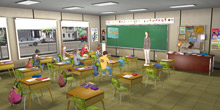
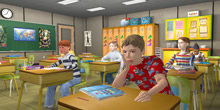
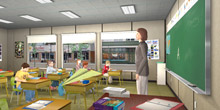

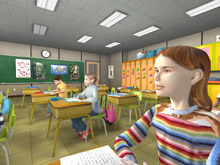

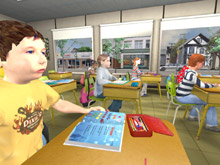
Virtual Classroom
Overview
 The virtual classroom project places children in a virtual classroom scenario to aid in the diagnosis of Attention Deficit Hyperactivity Disorder. These tests measure a child's ability to maintain attention when faced with various distractions.
The virtual classroom project places children in a virtual classroom scenario to aid in the diagnosis of Attention Deficit Hyperactivity Disorder. These tests measure a child's ability to maintain attention when faced with various distractions.
Virtual Environment NSF Report (Year 7)
Virtual Environment NSF Report (Year 8)
Focus
 We have developed a HMD-delivered Virtual Reality (VR) system for the assessment and possible rehabilitation of attention processes. Our rationale for choosing this cognitive process relates to the wide spread occurrence of attention impairments seen in a variety of clinical conditions and our belief that VR provides specific assets to address these impairments that are not available using existing methods. Virtual reality HMDs are well suited for these types of applications as they serve to provide a controlled stimulus environment where cognitive challenges can be presented along with the precise delivery and control of “distracting” auditory and visual stimuli.
We have developed a HMD-delivered Virtual Reality (VR) system for the assessment and possible rehabilitation of attention processes. Our rationale for choosing this cognitive process relates to the wide spread occurrence of attention impairments seen in a variety of clinical conditions and our belief that VR provides specific assets to address these impairments that are not available using existing methods. Virtual reality HMDs are well suited for these types of applications as they serve to provide a controlled stimulus environment where cognitive challenges can be presented along with the precise delivery and control of “distracting” auditory and visual stimuli.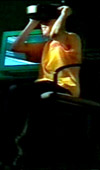 The prevalence of ADHD is estimated at 3%-5% in school age children with data on it's occurrence in adolescence and adulthood being somewhat limited. Within this "virtual classroom" scenario, children will be assessed in terms of attention performance while a series of typical classroom distracters (i.e. ambient classroom noise, movement of other pupils, activity occurring outside the window, etc. ) are systematically controlled and manipulated within the virtual environment. The child sits at a virtual desk within the virtual classroom and the environment can be programmed to vary with regards to such factors as seating position, number of students, gender of the teacher, etc.
The prevalence of ADHD is estimated at 3%-5% in school age children with data on it's occurrence in adolescence and adulthood being somewhat limited. Within this "virtual classroom" scenario, children will be assessed in terms of attention performance while a series of typical classroom distracters (i.e. ambient classroom noise, movement of other pupils, activity occurring outside the window, etc. ) are systematically controlled and manipulated within the virtual environment. The child sits at a virtual desk within the virtual classroom and the environment can be programmed to vary with regards to such factors as seating position, number of students, gender of the teacher, etc.Versions
 Version 1 - This 1st version of classroom was a prototype to establish usability based on user centered design principles. Feedback from tested children was incorporated in the evolution of version 2.
Version 1 - This 1st version of classroom was a prototype to establish usability based on user centered design principles. Feedback from tested children was incorporated in the evolution of version 2. Version 2 - This version, based on user feedback, evolved into a test scenario that was used to compare the performances of ADHD children vs. normal children. Here we see these children's attention span being motion tracked and mapped onto 3D avatars. This mapping, done in collaboration with the Immersidata Lab, displayed significant differences between ADHD and normal children.
Version 2 - This version, based on user feedback, evolved into a test scenario that was used to compare the performances of ADHD children vs. normal children. Here we see these children's attention span being motion tracked and mapped onto 3D avatars. This mapping, done in collaboration with the Immersidata Lab, displayed significant differences between ADHD and normal children. Version 3 - The overwhelming success of this research has served to spearhead an IMSC spin-off company and collaboration with The Psychological Corporation. Using the Unreal Tournament game engine, children are now immersed into a fully customizable, graphically rich classroom, providing a range of simulations and experiences. As a product, the VR classroom is becoming a mainstream method of assessing ADHD for school systems and clinicians alike.
Version 3 - The overwhelming success of this research has served to spearhead an IMSC spin-off company and collaboration with The Psychological Corporation. Using the Unreal Tournament game engine, children are now immersed into a fully customizable, graphically rich classroom, providing a range of simulations and experiences. As a product, the VR classroom is becoming a mainstream method of assessing ADHD for school systems and clinicians alike.Video [quicktime] | [winmedia]
Virtual Classroom Technology Summary
Virtual Office Technology Summary
Virtual Environment NSF Report (Year 7)
NSF Report (Year 8)
Poster
More Info
For more information, contact Ann Spurgeon at aspurgeo@imsc.usc.edu.